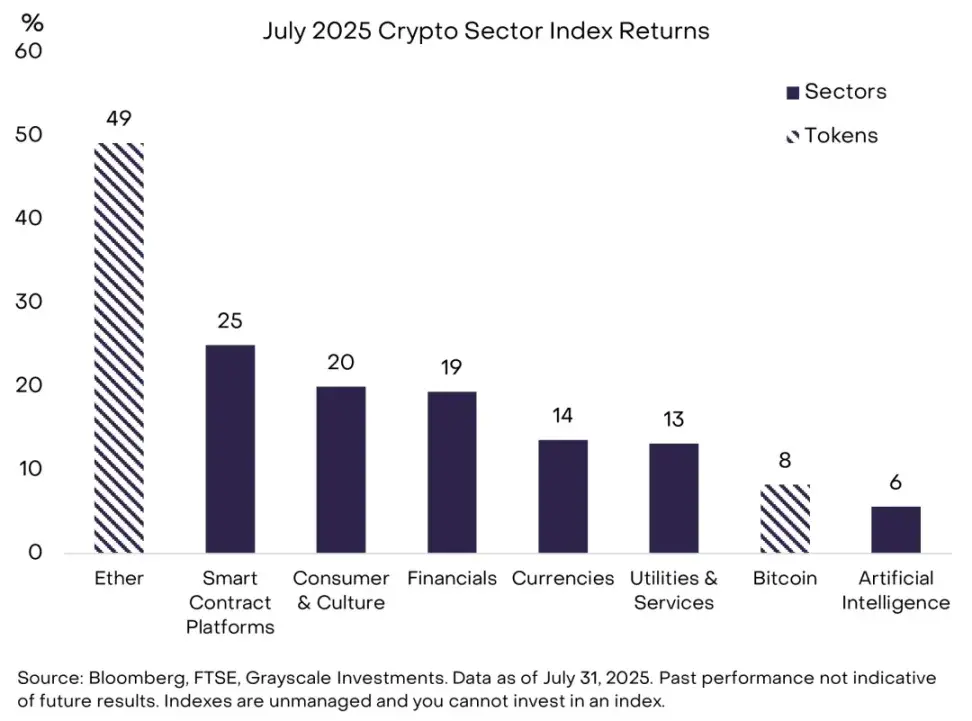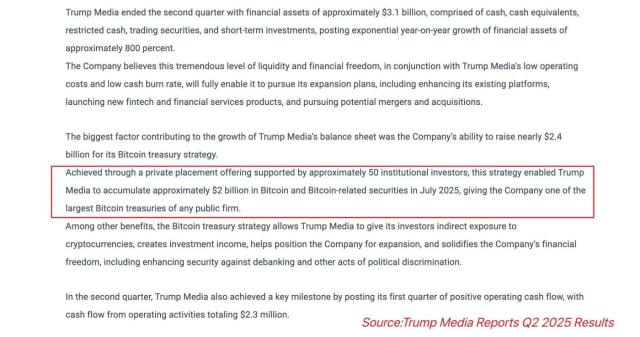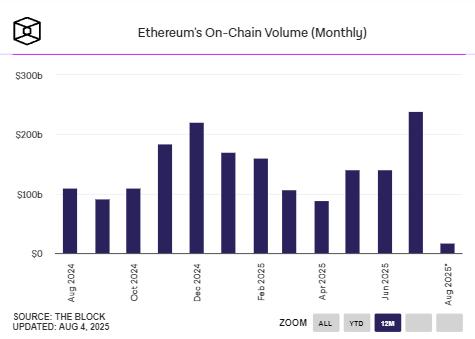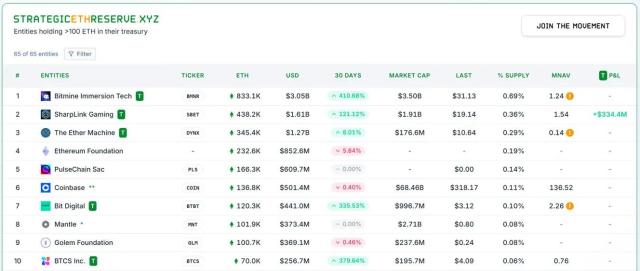Source: Grayscale
Compiled by: Blockchain in Plain Language
Original Title: Grayscale Research: Multiple Positive Factors Behind Ethereum's Strong Rise with Institutional Influx and Regulatory Approval
In July 2025, the ETH price on the Ethereum network surged nearly 50%. Investors focused on stablecoins, asset tokenization, and institutional adoption - areas that represent Ethereum's core advantages as the oldest smart contract platform.
The passage of the GENIUS Act is a milestone for stablecoins and the entire crypto asset category. While market structure-related legislation may take time to pass in Congress, US regulators can continue to support digital asset industry development through other policy adjustments, such as approving staking functions in crypto investment products.
In the short term, crypto asset valuations may consolidate, but we remain very optimistic about the asset class's prospects in the coming months. Crypto assets provide investors with an opportunity to engage with blockchain innovation while potentially offering some immunity to traditional asset risks like ongoing US dollar weakness. Therefore, Bitcoin, ETH, and many other digital assets are expected to continue attracting investor interest.
On July 18, President Trump signed the GENIUS Act, providing a comprehensive regulatory framework for US stablecoins. This marks the "end of the beginning" for the crypto asset category: public blockchain technology is moving from the experimental stage to the core of a regulated financial system. The debate about whether blockchain technology can bring real benefits to mainstream users has ended, and regulators are now focusing on ensuring industry growth with appropriate consumer protection and financial stability mechanisms.
In July, the crypto market celebrated the passage of the GENIUS Act and was supported by favorable macromarket conditions. Stock market indices rose in most global regions, with fixed income market returns led by high-risk sectors like US high-yield corporate bonds and emerging market bonds (see Chart 1). As market volatility decreased, related investment strategies performed quite well.
The FTSE/Grayscale Crypto Asset Market Index (a market-cap-weighted investable digital asset index) rose 15%, while Bitcoin's price grew 8%. Ethereum's ETH was the star of the month, with its price surging 49% and accumulating a total increase of over 150% since its April low point.
[Image]
Chart 1: Ethereum Shines Brightly in Crypto Asset Performance in Mid-July
Don't Call This a "Comeback"
Ethereum is the largest market cap smart contract platform and the infrastructure of blockchain finance. However, until recently, ETH's price performance was far behind Bitcoin and even lagged behind other smart contract platforms like Solana. This led some to question Ethereum's development strategy and its competitive position in the industry (see Chart 2).
[Image]
Chart 2: Ethereum Outperforms Bitcoin Since May
The renewed enthusiasm for Ethereum and ETH may reflect market focus on stablecoins, asset tokenization, and institutional blockchain adoption - Ethereum's strengths (see Chart 3). For example, the Ethereum ecosystem, including its Layer 2 networks, carries over 50% of stablecoin balances and processes about 45% of stablecoin transactions (by dollar value).
Ethereum is also the home of approximately 65% of total value locked in DeFi protocols and nearly 80% of tokenized US Treasury products. For many institutions building crypto projects, including Coinbase, Kraken, Robinhood, and Sony, Ethereum has been the preferred network.
[Image]
Chart 3: Ethereum is the Leading Blockchain for Stablecoins and Tokenized Assets
[... rest of the text continues in the same translated manner]
In addition, Adam Back, an early Bitcoin pioneer and CEO of Blockstream, announced the establishment of a new Bitcoin fund management strategy company - Bitcoin Standard Fund Management Company ($ BSTR). The company will use Back and other early adopters' BTC as capital and will raise equity. The BSTR transaction is very similar to the SPAC (Special Purpose Acquisition Company) transaction previously organized by Cantor Fitzgerald for Twenty One Capital - another large Bitcoin fund management strategy company supported by Tether and SoftBank.
Crypto Asset Boom
In July, valuations across crypto market sectors increased. From a crypto asset sector perspective, the best-performing sector was the smart contract sector (thanks to ETH's 49% increase), while the worst-performing was the artificial intelligence sector, dragged down by the special weakness of a few tokens (see Chart 6). During July, many crypto assets' futures open interest and financing rates (financing costs for leveraged long positions) increased, indicating enhanced investor risk appetite and increased speculative long positions.

Chart 6: All Crypto Market Sectors Rose in July
After experiencing strong returns, valuations may see some pullback or consolidation. The passage of the GENIUS Act is a major positive for the crypto asset category, driving absolute and risk-adjusted returns. Congress is also considering crypto market structure legislation, with the House's CLARITY Act receiving bipartisan support on July 17. However, the Senate is reviewing its own market structure legislation version, with no significant progress expected before September. Therefore, legislative catalysts supporting crypto asset valuations in the short term may be limited.
Summary
Nevertheless, we remain very optimistic about the crypto asset prospects in the coming months. First, even without legislation, regulatory tailwinds exist. For example, the White House recently released a detailed report on digital assets, proposing 94 specific recommendations to support the US digital asset industry. Of these, 60 fall under regulatory agency jurisdiction (the remaining 34 require Congressional or joint Congressional and regulatory action). With regulatory support, crypto investment products (such as staking features or broader spot crypto ETPs) may attract new capital into the asset class.
Secondly, we expect the macro environment to continue to favor crypto assets. These assets provide investors with opportunities to access blockchain innovation while offering some immunity to certain risks of traditional assets (such as ongoing USD weakness). In addition to crypto-related legislation passed in July, President Trump also signed the One Big Beautiful Bill Act, locking in massive federal budget deficits for the next decade.
He also explicitly stated his desire for the Federal Reserve to lower interest rates, emphasizing that a weaker dollar would benefit US manufacturing and increased tariffs on various products and trade partners. Massive budget deficits and lower real interest rates may continue to pressure dollar value, especially with implicit White House support. Scarce digital commodities like BTC and ETH may benefit as a result, serving as partial hedging tools in portfolios facing ongoing dollar weakness risks.







